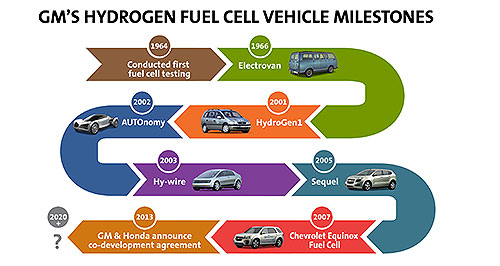News - General News - EmissionsGM and Honda team up on hydrogenBright spark: Honda’s FCX Clarity fills up with hydrogen that is used to power an electric motor tucked under the car’s bonnet. US, Japanese car giants work together on next generation of fuel cell vehicles3 Jul 2013 By BARRY PARK GENERAL Motors will team up with Formula One’s prodigal son, Honda, to work on vehicles that produce no emissions other than water. The collaboration, announced yesterday, will result in the US and Japanese car-makers working together on the next generation of fuel-cell technology that creates electricity by combining hydrogen and oxygen to produce water. However, the technology is still at least seven years away, with the car-makers aiming for a 2020 launch of a co-developed model. The pair is interested in developing fuel-cell technology because the refuelling experience is very similar to today’s cars, while a hydrogen-fuelled vehicle’s range is much greater than battery-fed electric cars. Honda has a longer run of experience with modern-day fuel cell technology than GM, having launched the FCX – an abbreviation for “fuel cell experimental” – in the US back in 2002. The original Honda vehicle was based on a three-door hatchback, but has since evolved into a mid-size sedan named the FCX Clarity. The front-wheel-drive FCX Clarity uses a next-generation fuel stack to convert the hydrogen fuel to electricity, as well as a capacitor for storing electricity generated while the car is slowing or braking. Its performance is modest by petrol-engined car standards – it produces only 100kW of power, or about the same as a 1.8-litre Toyota Corolla – although the 256Nm of torque it produces almost from idle matches a decent-sized V6. GM launched its Project Driveway program in 2007 using a converted Chevrolet Equinox SUV. Details of its performance are difficult to find. While Honda has already announced that it will launch the next generation of its FCX Clarity in the US and Europe in 2015, GM says it will leave any announcement about its fuel cell production plans to “a later date”. Between them, GM says it and Honda hold the rights over more than 1200 patents relating to fuel-cell technology. Mercedes-Benz is another car-maker investing heavily in fuel cell technology as a potential replacement for internal combustion engines. It brought the B-Class-based F-Cell to Australia in 2011 to showcase the technology. Other car-makers, including Audi, BMW and Hyundai have launched research programs using experimental hydrogen fuel cell vehicles. Ford, Nissan and Daimler earlier this year also announced the formation of a partnership to develop and launch “affordable, mass market” hydrogen fuel cell electric vehicles (FCEVs) within five years. Hydrogen as a fuel is also compatible with internal combustion engines – both BMW via its Hydrogen7 limousine and Mazda via its RX-8 RE sports car burn the fuel as opposed to use it to generate electricity.  Read more |
Click to shareGeneral News articlesResearch General News Motor industry news |
























Facebook Twitter Instagram